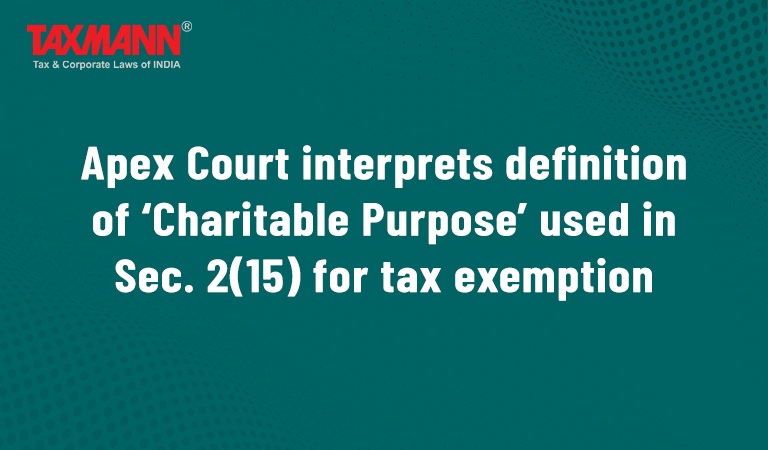Apex Court interprets definition of ‘Charitable Purpose’ used in Sec. 2(15) for tax exemption
- Blog|News|Income Tax|
- 2 Min Read
- By Taxmann
- |
- Last Updated on 22 October, 2022

Case Details: ACIT(exemption) v. Ahmedabad Urban Development Authority - [2022] 143 taxmann.com 278 (SC)
Judiciary and Counsel Details
-
- Uday Umesh Lalit, CJI, S. Ravindra Bhat & Pamidighantam Sri Narasimha, JJ.
Facts of the Case
The primary question before the Supreme Court was the correct interpretation of the proviso to Section 2(15) which defines ‘Charitable purpose’.
Supreme Court Held
The Supreme Court of India has clarified that an assessee advancing general public utility cannot engage itself in any trade, commerce, or business, or provide service in relation thereto for any consideration.
However, in the course of achieving the object of General Public Utility (GPU), the concerned organization can carry on trade, commerce, or business or provide services in relation thereto for consideration, provided that:
(i) The activities of trade, commerce, or business are connected to the achievement of its objects of GPU; and
(ii) The receipt from such business or commercial activity or service in relation thereto does not exceed the quantified limit, i.e., 20% of total receipts of the previous year.
Charging of any amount towards consideration for such an activity (advancing general public utility), which is on a cost-basis or nominally above cost, cannot be considered to be “trade, commerce, or business” or any services in relation thereto.
It is only when the charges are markedly or significantly above the cost incurred by the assessee, they would fall within the mischief of “cess, or fee, or any other consideration” towards “trade, commerce or business”.
Further, Section 11(4A) must be interpreted harmoniously with Section 2(15), with which there is no conflict. Carrying out activity in the nature of trade, commerce or business, or service in relation to such activities, should be conducted in the course of achieving the GPU object, and the income, profit, or surplus or gains must, therefore, be incidental.
The requirement in Section 11(4A) of maintaining separate books of account is also in line with the necessity of demonstrating that the quantitative limit prescribed in the proviso to Section 2(15), has not been breached.
The assessing authorities must every year, scrutinize the record to discern whether the nature of the assessee’s activities amounts to “trade, commerce or business” based on its receipts and income (i.e., whether the amounts charged are on a cost-basis, or significantly higher).
If it is found that they are in the nature of “trade, commerce or business”, then it must be examined whether the quantified limit (as amended from time to time) in the proviso to Section 2(15), has been breached, thus disentitling them to exemption.
Disclaimer: The content/information published on the website is only for general information of the user and shall not be construed as legal advice. While the Taxmann has exercised reasonable efforts to ensure the veracity of information/content published, Taxmann shall be under no liability in any manner whatsoever for incorrect information, if any.

Taxmann Publications has a dedicated in-house Research & Editorial Team. This team consists of a team of Chartered Accountants, Company Secretaries, and Lawyers. This team works under the guidance and supervision of editor-in-chief Mr Rakesh Bhargava.
The Research and Editorial Team is responsible for developing reliable and accurate content for the readers. The team follows the six-sigma approach to achieve the benchmark of zero error in its publications and research platforms. The team ensures that the following publication guidelines are thoroughly followed while developing the content:
- The statutory material is obtained only from the authorized and reliable sources
- All the latest developments in the judicial and legislative fields are covered
- Prepare the analytical write-ups on current, controversial, and important issues to help the readers to understand the concept and its implications
- Every content published by Taxmann is complete, accurate and lucid
- All evidence-based statements are supported with proper reference to Section, Circular No., Notification No. or citations
- The golden rules of grammar, style and consistency are thoroughly followed
- Font and size that’s easy to read and remain consistent across all imprint and digital publications are applied




